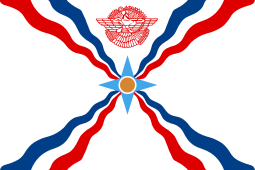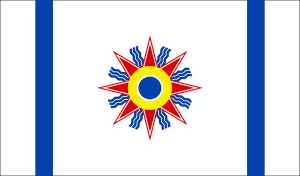Assyrian cuisine
Assyrian cuisine is the cuisine of the indigenous ethnic Assyrian people, Eastern Aramaic-speaking Syriac Christians of Iraq,[1] northeastern Syria, northwestern Iran and southeastern Turkey. Assyrian cuisine is primarily identical to Iraqi/Mesopotamian cuisine, as well as being very similar to other Middle Eastern and Caucasian cuisines, as well as Greek cuisine, Levantine cuisine, Turkish cuisine, Iranian cuisine, Israeli cuisine, and Armenian cuisine, with most dishes being similar to the cuisines of the area in which those Assyrians live/originate from.[2] It is rich in grains such as barley, meat, tomato, herbs, spices, cheese, and potato as well as herbs, fermented dairy products, and pickles.[3]
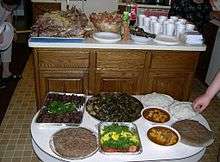
| Assyrian people |
|---|
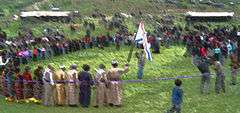 |
| Culture |
| Music |
| Language |
| Cuisine |
| Folk Dance |
| Religion |
| Clothing |
| Settlements |
| Tribes |
Overview
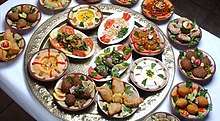
Rice is usually served with every meal accompanied by a stew which is typically poured over the rice. Tea is typically consumed at all times of the day with or without meals, alone or as a social drink. Cheese, crackers, biscuits, baklawa, or other snacks are often served alongside the tea as appetizers. Dietary restrictions may apply during Lent in which certain types of foods may not be consumed; often meaning animal-derived.
The primary difference between Assyrian and other Middle Eastern cuisines is that alcohol is rather popular, with several brewing traditions specifically in the form of arak, wheat beer, and organic wine being prevalent amongst them. Unlike in Jewish cuisine and Islamic cuisines in the region, pork is allowed as Assyrians are Christians, however, it is not widely consumed in the Arab countries, Turkey or Iran because of restrictions upon availability imposed by the Muslim majority.
Variations of cuisine and regional differences
Most of the time, the preparation of meals by the Assyrian diaspora (those living outside their ancestral homelands) reflects the region in which the individual ancestors are from. The foods consist of similar ingredients however the manner in which they are prepared slightly varies from region to region. In the Assyrian diaspora, individuals tend to combine the authentic Assyrian meals with the ethnic meals of that particular region.
Because Assyrians are now an ethnic minority and religious minority in all regions they traditionally live, their local cuisine also contains elements of neighboring societies and ethnic groups. The majority of Iraqi cuisine is incorporated into Iraqi Assyrian cuisine and the same is the case for Assyrians of Iran, Syria, or Turkey. Falafel with amba for example is very popular amongst Assyrians and are especially common during lent and other holidays requiring dietary restrictions that call for abstinence from animal-derived products and foods. They have also been inspired by Turks and Persians, and would eat a dish called bushala, which is a yogurt soup equivalent to Iranian's Ash-e doogh, containing leafy vegetables. This dish is not known among most Tyari peoples, where they instead use the term bushala for a type of soup (similar to India's curd rice) that contains only yogurt and rice which can be seasoned with butter and olive oil. This dish is known as girdoo in other Assyrian tribes, to differentiate it from the leafy soup of the same bushala name.
Breakfast
Common breakfasts include fried eggs and tomatoes seasoned with various spices, and scrambled eggs mixed with vegetables. Soft-boiled eggs are often made when members of the household are sick as many believe it to be very healthy. Harissa, a traditional Assyrian porridge made of chicken, wheat, and a generous amount of butter, usually made during Christmas, is also eaten as a breakfast by some because it is perceived as a heavy and nutritious meal. Home-made yogurt called mastā can be eaten plain with bread, or mixed with cucumbers, garlic, salt, mint, and olive oil called "jajik".
Assorted cheeses and "samoon" (thick Assyrian bread) are also quite popular. Baklawa, kelecheh, and kadeh may also be eaten during breakfast time. "Gehmar" is a rich cream that is consumed with honey or date syrup on samoon. During Lent, meat and dairy products are frowned upon for religious reasons, and many Assyrians typically fry a mixture of diced tomatoes, onions, potatoes, and green peppers with a generous amount of olive oil, adding to it spices such as curry, red pepper, paprika, salt, and pepper. This is generally eaten with samoon, lawasha (flat, unleavened pita) or pita bread. Lenten breakfasts also include tahini mixed with fig or date syrup called "napukhta" which is again eaten with the breads mentioned previously. Halawah, which is a sesame paste mixed with pistachios, is also popular during Lent.
Appetizers
Assyrian maza (ܡܙܐ) is similar to related cuisines' Mezes which may include hummus (ḥemṣē ṭḥīnē), baba ghanouj, tapoula, fattoush, vegetables and dip, burek (fried egg roll stuffed with either ground beef or chicken, onions, parsley, and various spices), etc. fava beans, known as baqqilē, and chick peas, known as ḥemṣē or ḥerṭmanē (ܚܪܛܡܢܐ), are very common in soups, salads, and find their way into many foods. Fried almonds and raisins are also used but not as appetizers but rather as garnishes for main dishes. "Potato chap" is deep fried mashed potatoes stuffed with ground beef, parsley, and onion.
"Kubba" made with ground beef and an outer shell of ground wheat is flattened and then fried or oven baked is another maza favorite, and is often eaten with ketchup or steak sauce. Another popular maza is tourshee which literally means pickled. Many different types of vegetables are pickled such as cucumbers, cabbage, carrots, cauliflower, beets, and peppers.
It is very true that the Assyrian diet is influenced by the food of the particular region in which people live in the diaspora, but nonetheless, Assyrians have their own foods distinct from the area where they live. Tourshea is a pickled vegetable which is Assyrian. In the United States of America, the influence of the US diet is seen by many people adding sugar to the pickles, whereas Assyrians from the Middle East, do not add sugar. Dolma (stuffed vegetables), grape leaves (dolma durpeh) and cabbage (dolmeh kalama) are Assyrian foods.
It is the US Assyrians who are the least influenced by the food in the US probably because the US diet and the Assyrian foods are so distinctly different. Reesheh shickle, pork soup is another Assyrian dish, although due to being pork, is not that common. The dill rice with lima beans is purely Iranian, whereas the Assyrian rice is baked with pure butter. Assyrians have a distinct khoodoosh, stew made of green beans and red meat. Harissa is the Assyrian holiday food made with a whole chicken and pirda (wheat). These are considered the "pure" Assyrian foods.
Lunch and dinner
There is no difference to lunch and dinner to Assyrians as there are with some other cultures, they are referred to as kawitrā w kharamsha, or ˁurāytā w ḥšāmtā (ܚܕܝܐ ܘ ܥܫܝܐ). Lunch and dinner typically consist of basmati rice which can be prepared either plain, red (smooqah), yellow (zardah), or plain with fried miniature noodles called sha'riya. Alternatively, there is also green rice (reza qeena), which is flavoured and seasoned with lima beans and dill, which give it a green colour. In place of rice, gurgur (burghul or "perda" in Assyrian) can be prepared in the same way as rice. Beef and chicken Kebab, grilled on skewers or a spit, are also commonly eaten at mealtime.
Biryani is an Assyrian rice dish with sha'riya made of green peas, fried cubed potatoes, almonds, raisins, sliced hard boiled eggs, and chicken. Rezza Smooqah (red rice) is often made with chicken or meat. Rice is usually accompanied with a stew, called shirwah, with a broth basis (prepared with tomato paste, water, spices) and a main vegetable ingredient (potatoes, beans, okra, string beans, spinach, cauliflower, or zucchini). Beef, chicken, or ox tails can be added according to taste and availability. During Lent, meat is omitted for religious reasons. A traditional Assyrian salad is cubed tomatoes, cucumbers, peppers, and red onions made with a homemade dressing of lemon, vinegar, salt, pepper, and olive oil.
Other various types of Assyrian special dishes include thlokheh (lentils cooked with curry and sha'riya), kofta (kipteh, ground beef meatballs flavored with parsley, rice, onion, and spices in a tomato based stew), kuba hammouth (ground beef long meatballs with an outer cracked wheat shell, much similar to Syrian and Lebanese fried kibbeh), and girdo (or girdu) is a porridge made of rice and sour yoghurt, served with date or fig syrup.[3][4][5]
Other traditional Assyrian specialities include Tepsi (a casserole made in layers of fried potato, fried eggplant, fried green peppers, fried onions, meat, and tomatoes drenched in a tomato sauce and baked in the oven, not unlike the Levantine version of moussaka), shamakhshi (fried rolled eggplant stuffed with ground beef in tomato sauce), Dolma (rice and tomato sauce stuffed in grape leaves, cabbage, various peppers, zucchini, and eggplant), Masgouf (fish spiced with olive oil, salt, and turmeric, topped with tomatoes, potatoes, and onions then oven-baked) and Lahmacun (flatbread topped with ground beef, tomato paste, spices, and onions).
Sesame seeds are important to the cuisine and used to make tahini, there is even an Assyrian folk tale about the gods drinking sesame wine on the night before they created the earth.[6]
Soups and stews
Boushala (or bushala) is one of the oldest known dishes, it is a yoghurt-based soup with assorted greens such as swiss chard or spinach and bulgur wheat.[3] This soup can be served hot or cold.[3] Dikhwah (or dokhwa) is a dried yoghurt-based heavy stew with barley and meat.[5]
Harissa (or hareesa) is a porridge made with hulled wheat berries, and deboned chicken or beef, and broth, sometimes eaten with butter or cinnamon.[3]
Tashrib (or tashreeb) a soup made of chickpeas, onions, and chicken or lamb meat, often served on top of bread at breakfast.[7][8] Tashrib is similar to a Syrian dish called fatta and an Iraqi dish called tashghib, there are variations of the dish that may include more toppings like lentils, noodles, and pomegranate.[8]
Pacha (is similar to Armenian and Turkish dishes) this heavy stew consists of lamb stomach stuffed with rice, brain, tongue, liver, or offal.[9]
Desserts
There are several different types of desserts such as cakes and cookies, which include baklava, kulecheh, kadeh, nazoochi, and others. Due to the influence from the post-Ottoman occupation of Iraq and Syria by the British and French many customs were picked up from the colonial administrators, and tea and biscuits are often eaten as snacks.
Kadeh looks like a thick yellowish flat bread though it contains plenty of butter, eggs, and sugar which renders it a very sweet pastry. Kadeh are usually prepared alongside kulecheh and are served during Christmas.[3] Nazoochi is similar to kadeh but sweeter and cut into a triangle shape; it is served during tea time or during social events.[3]
Beverages
Alcoholic beverages are consumed at different rates in the Assyrian community depending on geography.[3] Arak is one of the most popular alcoholic beverages and can be distilled from grapes or dates.[3] It is a strong alcohol so it is often served with food; it tastes like black liquorice and is clear until mixed with water, which then becomes milky-white. Assyrian rural communities have often traditionally brewed their own organic wheat beer and produced their own wine.
Daweh is a popular yogurt drink made with yogurt, water, salt, and sometimes mint. It is consumed during the summer when it is hot.[3]
Black tea is almost always drunk in the morning with Assyrian breakfast. Assyrian tea is drunk with sugar and evaporated milk, as opposed to regular milk or cream. Dried lime tea, or chai noomi basra, an Arab herbal tea, may be consumed to treat upset stomachs and indigestion.
Traditional Assyrian coffee is made in a large bronze jezve (which is covered with Assyrian imagery) and is served sweetened, similar to Turkish coffee.[10] Turkish coffee, which is a hold-over from Ottoman times, is often prepared the same way.
Gallery
 Bushala (or boushala)
Bushala (or boushala) Typical kubba
Typical kubba Kipteh
Kipteh Okra stew
Okra stew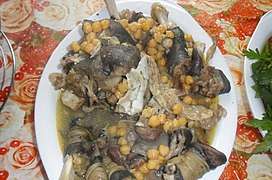 Pacha
Pacha Dolma
Dolma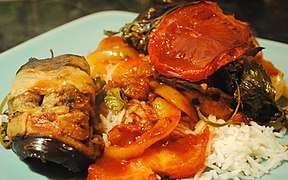 Tepsi
Tepsi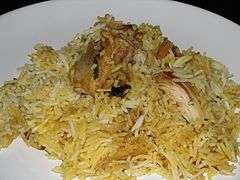 Biryani
Biryani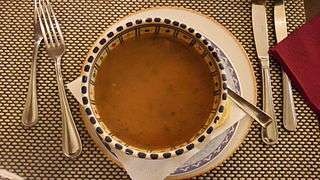 Tlokheh (lentil soup)
Tlokheh (lentil soup) Kouba stew
Kouba stew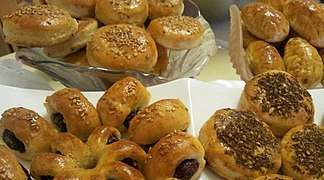 Kelecheh
Kelecheh Hareesa (wheat porridge)
Hareesa (wheat porridge)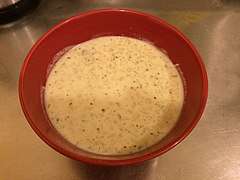 Dekhwa (barley soup)
Dekhwa (barley soup) Gerdoo
Gerdoo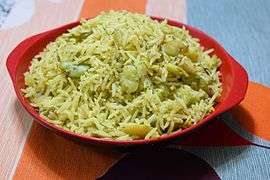 Green rice
Green rice
References
- Levitt, Aimee. "Enemy Kitchen, a food truck and public art project, serves up hospitality in place of hostility". Chicago Reader. Retrieved 2018-03-21.
- Mandel, Pam (2017-12-05). "An Ancient Empire Gets New Life — on a Food Truck". Jewish in Seattle Magazine. Retrieved 2018-03-21.
- Edelstein, Sari, ed. (2011). Food, Cuisine, and Cultural Competency for Culinary, Hospitality, and Nutrition Professionals. Boston, Massachusetts: Jones & Bartlett Learning. pp. 545–552. ISBN 0763759651.
- Peggie Jacob. "Peggie's Mediterranean Cookbook" Morris Press
- Conway, Sarah (2017-03-24). "Why You Should Eat Like the Ancient Assyrians Ate". Assyrian International News Agency (AINA). Retrieved 2018-03-21.
- "Why Sesame is an Incredible Ingredient to Use in Different Cuisines". NDTV Food. Retrieved 2018-03-21.
- "10 Iraqi Foods That Will Acquaint You to the Primitive Flavors of Mesopotamia". Flavorverse. 2018-01-06. Retrieved 2018-03-21.
- Davidson, Alan (2014). The Oxford Companion to Food. United Kingdom: Oxford. p. 415. ISBN 019104072X.
- "AAA of Modesto Assyrian Food (Patcha)". 2005-12-18. Retrieved 2018-03-21.
- "Just Don't Call it Turkish Coffee - Roads & Kingdoms". Roads & Kingdoms. 2014-04-17. Retrieved 2018-03-21.
